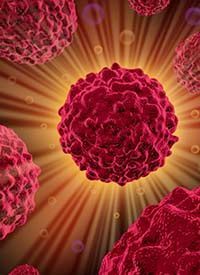Article
Mutational Status Is Associated With Time to First Treatment in Newly Diagnosed CLL
Author(s):
The presence of at least 1 mutation captured by next-generation sequencing was associated with a shorter time to first treatment among patients with newly diagnosed chronic lymphocytic leukemia, particularly those with mutations in POT1, ATM, FBXW7, and MYD88 genes.

The presence of at least 1 mutation captured by next-generation sequencing (NGS) was associated with a shorter time to first treatment among patients with newly diagnosed chronic lymphocytic leukemia (CLL), particularly those with mutations in POT1, ATM, FBXW7, and MYD88 genes, according to findings from a study that were presented during the 2021 International Workshop on CLL.1
In univariate analysis, the presence of at least 1 mutation by NGS was indicative of shorter time to first treatment (P < .001). Specifically, the presence of mutations in ATM (P < .001), POT1 (P < .001), NOTCH1 (P < .001), XPO1 (P = .002), SF3B1 (P = .007), TP53 (P = .022), MYD88 (P = .041), and FBXW7 (P = .045) was associated with shorter time to first treatment.
Other features associated with shorter time to first treatment were unmutated IGHV (P < .001), trisomy 12 (P = .007), and 11q deletion (P = .004).
Multivariate analysis indicated that features that were independently associated with shorter time to first treatment included unmutated IGHV (HR, 2.2; 95% CI, 1.4-3.6; P = .001), an ATM mutation (HR, 2.3; 95% CI, 1.3-4.2; P = .005), FBXW7 mutation (HR, 3.1; 95% CI, 1.3-7.3; P = .012), MYD88 mutation (HR, 4.9; 95% CI, 2.0-11.6; P < .001) and POT1 mutation (HR, 3.3; 95% CI, 1.6-6.6; P = .001).
“Time to first treatment has recently emerged as an important end point for untreated CLL patients, able to identify early drivers of disease which may be masked when investigating long-term and treatment-defined outcomes, such as progression-free survival and overall survival,” lead study author Caterina Cristinelli, MD, of the Department of Molecular Medicine at the University of Pavia in Pavia, Italy, and coauthors wrote in the poster presentation.
“Our study demonstrates that one-third of patients with Binet stage A CLL harbor somatic mutations with prognostic relevance and confirms the value of NGS for the identification of predictors of time to first treatment in early-stage CLL.”
Given the heterogeneity of CLL and limited understanding of the prognostic and predictive role of recurrently mutated somatic alterations in the treatment-naïve setting, investigators performed NGS to evaluate 10 targeted genes in patients with Binet stage A CLL.
Mononuclear cells were isolated from peripheral blood in 182 patients and from bone marrow in 29 patients. Targeted mutation analysis was performed with a Truseq Custom Amplicon panel.
The variant analysis was restricted to oncogenic variants with an allele frequency of at least 1%, and mutations were deemed subclonal when the variant allele frequency (VAF) was less than 12% and clonal when the VAF was at least 12%.
The VAF in unselected mononuclear cells was adjusted for the percentage of CLL cells quantified by immunophenotype.
At a median follow-up of 96 months (interquartile range [IQR], 65-138), 108 patients (51%) received treatment. The median time to first treatment was 6 years (95% CI, 5-12).
The median patient age was 62 years (IQR, 54-69), and most patients were male (n = 121; 57%).
Additional results showed that 113 mutations were identified in 74 of 211 patients (35%), and co-occurring mutations in at least 2 genes were identified in 24 of 74 cases (32%).
ATM mutations were found in 20 patients (9%); 6 of 20 patients with ATM mutations had 11q deletion by fluorescence in situ hybridization (FISH). SF3B1 mutations were found in 14 patients (7%).
Fourteen XPO1 mutations were found in 13 patients (6%) and most of them (n = 13/14) were located at E571. All but 1 patient harboring the XPO1 mutation showed evidence of unmutated IGHV.
TP53 mutations were identified in 11 patients (5%) and occurred at the DNA-binding domain of the protein. Four of 11 patients with TP53 mutations by NGS also had a 17p deletion by FISH.
“Neither TP53 mutations by NGS nor 17p deletions were associated with shorter time to first treatment. This, in keeping with prior studies, suggests that these abnormalities, which are strong prognostic factors in advanced or relapsed CLL, have limited roles in early untreated disease,” wrote the authors.
POT1 mutations were seen in 12 patients (6%), all of whom except 1 had unmutated IGHV.
NOTCH1 mutations were identified in 11 patients (5%), 10 of which were mutated at P2514 in the PEST domain. Nine of 11 patients who had NOTCH1 mutations also had unmutated IGHV.
Ten FBXW7 mutations were detected in 9 patients (4%), 5 of which had unmutated IGHV. Six of 11 patients with NOTCH1 mutations, and 5 of 10 patients with FBXW7 mutations had trisomy 12 by FISH. None of the patients with NOTCH1 mutations had a co-occurring FBXW7 mutation.
Seven MYD88 mutations were identified in 7 patients (3%), all of whom had mutated IGHV.
“The role of MYD88 mutations on clinical outcome of CLL patients remains controversial. In our series, MYD88 mutations were detected exclusively in patients with mutated IGHV, as previously reported, and were associated with a significantly shorter time to first treatment. Despite reports of favorable outcome of MYD88-mutated CLL patients, subsequent observations showed that MYD88 mutations are associated with shorter time to first treatment in mutated IGHV patients and may counteract the survival advantage of mutated IGHV,” wrote the authors.
Two KRAS mutations and 2 BIRC3 mutations were seen in 2 patients each (1%).
Reference
- Cristinelli C, Varettoni M, Orlandi E, et al. Prognostic impact of somatic mutations on time to first treatment: results of targeted next-generation sequencing in 211 patients with early stage chronic lymphocytic leukemia. Presented at: 2021 International Workshop on CLL; September 17-20, 2021; virtual. Poster 1083193.








